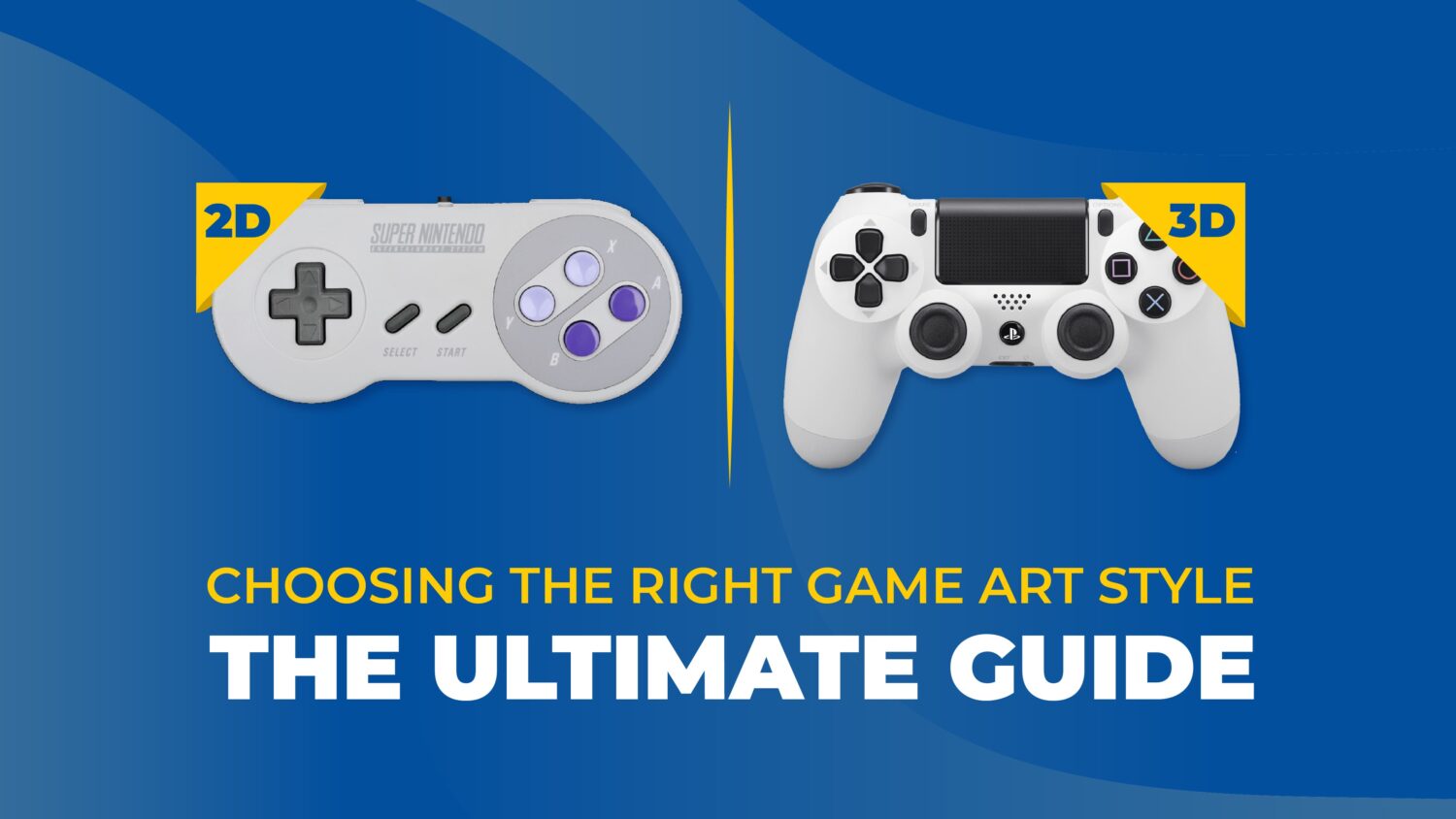Video games are a collision of art and science. Graphics are what the eyes of players capture first.
In a recent article, we provided a guide to game art outsourcing for game developers and showed them because we understand their high volume of work and the excessive focus they need to have.
But now, adding the difficulty of having to choose a style, we will introduce the different styles of game art, tell you where to go for examples, and ultimately, help you decide to go for one that goes with your game.
Every game must have its identity
We’ve had many clients who reached out to us to outsource their game art. This is what we ended up doing for the trading card game Cross The Ages:
Some had something in mind, while some asked for our advice. We analyzed the second group’s game and offered styles that would boost its aesthetics. The first kind showed us a reference, and we gladly did the job. But throughout the years, we came across a pattern.
We’ve noticed that most games today are very similar in looks and void of identity.
From the loading screen to where the gameplay takes place, your video game must feel different and distinguishable in order to stand out from other titles.
Our studio doesn’t claim that it can do any wizardry and make a flawed game look good with visuals, but we can assist you in bringing out the best of a good product and help you decide which style best suits your game.
All you have to do is tell us about your game
Picking a game art style that boosts your game’s aesthetics
Although it is admittedly difficult to pick a style out of all the options available, there are basically two things you need to do:
- Learn and know about the different styles that we’ve introduced in the next part of the blog.
- Find the answer to these questions:
- What resources do you have? Or better said: What’s your budget? Once you answer this, you’ll know where to go from there. Just remember not to underestimate the power of game trailers. If you’re developing an indie game, it doesn’t mean that a vast, hyper-realistic trailer can’t take it to the top.
- What is the essence of the game? A fast-paced action game would require clear visuals to allow viewers to make quick decisions, not a calming and contemplative atmosphere.
- Who is your audience? It’s essential to know whose expectations you’re trying to fulfill. Put yourself in their place and see the game from their point of view before going with a style.
- What are the technical limitations? Actually, it’s up to the game art studio to handle this side. All you have to do is provide the required information, and their tech art director will take care of the rest.
- What are the unique selling points of the game? Is it the core gameplay mechanics? Is it the narrative & storytelling? If it’s player engagement and longevity, an immersive style could be chosen. Or maybe your branding and market positioning is your secret weapon? In this case, the style should be very different than your competitors. A series of stunning video game trailers with mesmerizing visuals and the right release dates might just do the trick.
- What emotions are you trying to evoke? Game art is all about creating the “feel” of the game. For their masterpiece Heavy Rain, Quantic Dream created one of the saddest environments and used colors that portrayed the mood and state of the players.
3D game art design
As the name suggests, 3D game art is the three-dimensional depiction of characters, environments, and objects in the three dimensions of height, length, and width.
3D styles are great for:
- Generating moveable items and more realistic settings to give video games life.
- Exploring in-game surroundings and looking at things from various angles and views.
- Increasing player involvement, providing exciting aesthetics and immersive settings.
Most common 3D game art styles
1. Realism
This technique helps the artist stay truest to the object among other styles, and unsurprisingly, it’s become people’s favorite style. Most AAA games use this style to make gamers thirst for their newest releases with high graphic requirements. It can take a lot of time and resources to make complex fantasy landscapes, creatures, and textures.
Take Red Dead Redemption 2 and Uncharted 4: A Thief’s End, for instance. They create visually breathtaking landscapes that blur the boundaries between reality and gaming.
2. Fantasy realism
The grandeur of fantasy is combined with the aesthetic splendor of realism in the fantasy realism genre. In other words, this style contains highly realistic visuals that aren’t possible in real life. Imagine knights, dragons, and other fabled creatures portrayed in stunning realism. The breathtaking beauty of this aesthetic is displayed in games like The Elder Scrolls V: Skyrim, Cyberpunk 2077, and The Witcher 3: Wild Hunt.
3. Low poly
Low poly art is somewhat new yet popular. Artists use polygons to create 2D materials without utilizing any textures. The style embraces simplicity and consists only of geometrical shapes. However, this shouldn’t lead you to believe it’s an easy style. A lot of focus is put into shapes, materials, and lighting to make up for the absence of textures. Plus, each object or character is designed uniquely. Considering this in a game with thousands of assets, it takes a lot of time and tastefulness.
The low poly style embraces simplicity and turns complicated shapes into endearing, polygonal works of art. Low poly environments are seen in a game like Monument Valley, which is both basic and visually appealing at the same time.
4. Hand-painted
Imagine entering a living painting if it were hand-painted. The brilliant colors, brushstroke-like textures, and fantastical landscapes of hand-painted imagery are a visual feast.
Memories Retold, for example, is like playing in an oil painting, one that you’d find on your grandmother’s wall.
5. Cartoon
Cartoon art forms offer a fun and eye-catching experience. They enable oversized characters, vivid colors, and expressive animations, which give the game a whimsical and entertaining feel.
However, finding the ideal balance between readability and stylization can take a lot of work while creating a cartoon style, especially when trying to depict relationships and emotions.
The most famous examples of this art are Overwatch and Fortnite.

2D game art design
We make 2D game art for games that exist within a two-dimensional space. It consists of two-dimensional images and sprites to create characters, environments, and assets. Unlike 3D art, 2D is limited to a flat representation on the game screen.
But this doesn’t make 2D any less than 3D in the game art arena. In fact, most 3D games use 2D assets to create menus, options, backgrounds, and even a complete environment.
A 2D art game’s graphics could use a lot of improvement, but sometimes their colorfulness, line saturation, and ingenuity make up for these shortcomings.
Most common 2D game art styles
1. Flat
The art form embraces minimalism and clear lines while remaining simple and attractive. With the help of flat design, games like Monument Valley create visually magnificent settings and endearing characters that are equally fashionable and engaging.
Flat art’s benefits include simplicity, minimalism, and a clean appearance. It enables easy reading and a distinct visual language, making it perfect for expressing particular moods or emphasizing gaming components.
A strong understanding of composition, color theory, and graphic design principles is necessary to create flat art that is visually appealing. It might be difficult to maintain visual interest without coming out as overly basic.
2. Vector
Images made with the vector style have sharp edges and can be resized without losing quality because mathematical procedures are used to generate them. This offers versatility in asset creation and works well for 2D projects or mobile games with different resolutions.
We’ve seen vectors in games like BattleZone and Asteroids from the arcade times and in a modern release like The Banner Saga.
3. Geometric art
The simplest of them all, plus the name’s self-explanatory. Using geometric shapes, the artist creates an environment where the player controls one of the shapes and uses it to dodge or shoot at other shapes.
Thomas Was Alone is a game that honors the elegance and simplicity of geometry and provides a distinctive and visually fascinating experience.
While creating a game with geometric art style, it’s necessary to be accurate in geometric compositions and be able to strike the ideal balance between simplicity and intricacy.
4. Pixel
Pixel art’s great for creating that retro style and feel. With its associations with old-school games and retro design, pixel art holds a unique place in gamers’ hearts. Hotline Miami and Stardew Valley’s endearingly blocky figures and vivid, nostalgic environments are perfect for 80s games enthusiasts.
5. Cartoon
Prepare yourself for a dose of animated joy with the cartoon game art style, where characters are brought to life in a way that screams, “Fun awaits!” Cartoon art styles are prevalent in a game like Team Fortress 2, offering brilliant colors, exaggerated dimensions, and a joyful ambiance.
6. Cel shading
With cel-shaded art styles, enter a living comic book. Some may look at The Legend of Zelda: The Wind Waker and think it’s simply a cartoon game style, but this method imparts a hand-drawn or comic book-like appearance using flat colors and sharp contours. In Cel Shading, the light that falls on an object is altered, and the result looks as if it was a sketch rather than computer-generated.
7. Monochromatic
In a world of billions of colors and magical realism, black & white games have their fans too! This art style consists of using one color (black or white) as a base color and then using different shades of it to color everything. Although, I must note that sometimes, other colors are used in monochromatic designs, like different shades of green, orange, etc.
Limbo and Inside are the two most famous examples that have created immersive and ominous experiences within enthralling and eerie atmospheres.

Wrap-up time
It’s really easy to get lost in a world with too many game art styles (where a lot of them turn out to be similar in the end). But there are things game makers can do to avoid this much confusion.
Each art style brings its unique charm to the gaming universe. If you’re a game developer, you can start by getting to know some of the most prominent styles that are being used these days.
Another thing would be consulting a game art studio and telling them about your game so they can help you pick the best game art style.
Finally, knowing your game and where you want it to excel can put you steps ahead in making your choice.

Allen Rafiee
Allen is the Senior blog writer at Dream Farm Studios. In the five years he has been writing for startups and big companies, he challenged himself to learn all he could about digital marketing and finally became a key member of the Marcom team. When he's not doing all of that, you can find him teaching different languages, learning new recipes, and watching cool documentaries about, well, anything!

